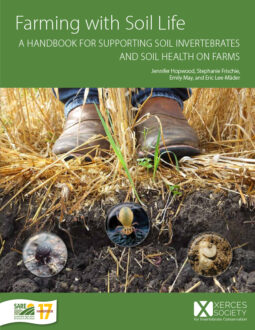This handbook, created by The Xerces Society, dives into soil biology. It provides a connection between healthy soils and healthy invertebrates found in temperate agricultural soils.
Farming with Soil Life starts with a review of soil basics, including the functions, classifications and properties (physical, biological and chemical) of soil. It provides detailed methods on how to observe soil life through pitfall traps, funnel surveys and slake tests, and also includes information on soil testing. The publication also addresses how common production practices can support or deter soil life, and includes a listing of USDA Natural Resources Conservation Service (NRCS) practices farmers can use to support soil organisms.
A unique contribution of the handbook is the inclusion of 73 profiles of invertebrates found in soils, including microfauna (protozoans) and numerous mesofauna species like mites, earthworms, slugs, millipedes, earwigs, cicadas, flies, beetles, ants, bees, and many more.
Soil is a living, dynamic habitat for a great diversity of animals and plants. ... We continue to learn more about the complexity of interactions between the living and non-living features below the surface, from plants, animals and fungi to soil physical and chemical properties. The more we learn, the more we understand that soil is an irreplaceable part of life."
Farming with Soil Life: A Handbook for Supporting Soil Invertebrates and Soil Health on Farms
Want more information? See the related SARE grant:
This material is based upon work that is supported by the National Institute of Food and Agriculture, U.S. Department of Agriculture through the Sustainable Agriculture Research and Education (SARE) program. Any opinions, findings, conclusions, or recommendations expressed in this publication are those of the author(s) and should not be construed to represent any official USDA or U.S. Government determination or policy.
